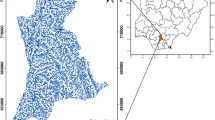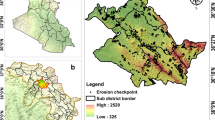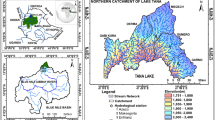Abstract
Present study aimed at estimating soil erosion potential and identification of critical areas for soil conservation measures in an ungauged catchment situated in Aravalli hills of Udaipur district, Rajasthan (India). Also, impact of rainfall on soil erosion is evaluated. The soil erosion is estimated for 10 year period (2001–2010) by Universal Soil Loss Equation (USLE) model using Geographical information system (GIS) and remote sensing techniques for every 12 m × 12 m area. Thematic maps of six USLE model parameters, i.e., rainfall erosivity (R-factor), soil erodibility (K-factor), slope length (L-factor), slope steepness (S-factor), crop and management (C-factor), and support practice (P-factor), were prepared in GIS platform. The R-factor ranged from 1,522.93 to 10,225.88 MJ mm ha−1 h−1 year−1 in the years 2006 and 2008, respectively, when the annual rainfall was 984.3 and 572.2 mm, and number of rainy days were 58 and 47, respectively. The K-factor was highest for fine loam soil covering 56 % area, while the lowest value was for coarse loamy sand in 22 % area. The lowest value of the L-factor (0.736) was in accordance with the high slopes nearby catchment boundary; whereas the highest value (0.832) was for almost zero slopes in 34 % area nearby waterbodies. Opposite to the L-factor, the S-factor values were high (>4) for the higher slopes nearby catchment boundary and the lowest values for the zero slopes. The C-factor value in 170.36 km2 or 48.91 % of the area is 0.1 while the value is zero for waterbodies and builtup lands. The P-factor value in 250.36 km2 or 71.87 % of the area is 0.8. The mean annual soil erosion in the major portion of the catchment (231.13 km2 or 66.38 %) exceeds 10 t ha−1 year−1 indicating high to very severe soil erosion conditions prevailing in the catchment. It is apparent that vast quantities of the soil are getting eroded from the catchment, and the annual rainfall amount and rainfall intensity have the profound effect on the soil erosion potential. This study emphasizes that USLE model coupled with GIS and remote sensing techniques are promising and cost-effective tools for mapping critical areas of soil erosion in ungauged catchments especially in developing countries.













Similar content being viewed by others
References
Beasley DB, Huggins LF, Monke EJ (1980) ANSWERS: a model for watershed planning. Trans ASAE 23(3):938–944
Brady NC, Weil RR (1999) The nature and properties of soils. Prentice Hall, Upper Saddle River 881 pp
Cowen J (1993) A proposed method for calculating the LS for use with the USLE in a grid-based environment. Proceedings of the 13th Annual ESRI User Conference Palm Springs, vol 1. California, pp 65–74
Dabral PP, Baithuri N, Pandey A (2008) Soil erosion assessment in a hilly catchment of north eastern India using USLE, GIS and remote sensing. Water Resour Manag 22:1783–1798
Desmet PJ, Govers G (1996) A GIS procedure for automatically calculating the USLE LS on topographically complex landscape units. J Soil Water Conserv 51:427–433
Ferro V (1997) Further remarks on a distributed approach to sediment delivery. Hydrol Sci J 42(5):633–647
Ferro V, Minacapilli M (1995) Sediment delivery processes at basin scale. Hydrol Sci J 40(6):703–717
Ferro V, Porto P, Tusa G (1998) Testing a distributed approach for modeling sediment delivery. Hydrol Sci J 43(3):425–442
Hadley RF, Lai R, Onstad CA, DE Walling, Yair A (1985) Recent developments in erosion and sediment yield studies. UNESCO (IHP) Publication, Paris
Hickey R, Smith A, Jankowski P (1994) Slope length calculations from a DEM within Arc/Info Grid. Comput Environ Urban Syst 18:365–380
ILWIS (2001) Integrated Land and Water Information System, 3.2 Academic, User’s Guide. International Institute for Aerospace Survey and Earth Sciences (ITC), The Netherlands, pp 428–456
Jain BL, Singh RS, Shyampura RL, Gajbhiye KS (2005). Land use planning of Udaipur District—soil resource and agro-ecological assessment., Publication No. 113, National Bureau of Soil Survey and Land Use Planning (NBSS&LUP), Nagpur, 69 p
Jain MK, Das D (2010) Estimation of sediment yield and areas of soil erosion and deposition for watershed prioritization using GIS and remote sensing. Water Resour Manage 24:2091–2112
Jain MK, Kothyari UC, Rangaraju KG (2005) Geographic information system based distributed model for soil erosion and rate of sediment outflow from catchments. J Hydraul Eng ASCE 131(7):755–769
Jain SK, Kumar S, Varghese J (2001) Estimation of soil erosion for a Himalayan watershed using GIS technique. Water Resour Manag 15:41–54
Kirkby MJ, Morgan RPC (1980) Soil erosion. Wiley, New York
Kothyari UC (1996) Erosion and sedimentation problems in India. Proceedings of international symposium on erosion and sediment yield: global and regional perspectives, Exeter, U.K., IAHS Publication No. vol 236, pp 531–539
Kothyari UC, Jain SK (1997) Sediment yield estimation using GIS. Hydrol Sci J 42(6):833–843
Kothyari UC, Jain MK, Raju KGR (2002) Estimation of temporal variation of sediment yield using GIS. Hydrol Sci J 47(5):693–706
Machiwal D, Mishra A, Jha MK, Sharma A, Sisodia SS (2012) Modeling short-term spatial and temporal variability of groundwater level using geostatistics and GIS. Nat Resour Res 21(1):117–136
Machiwal D, Nimawat JV, Samar KK (2011) Evaluating efficacy of groundwater level monitoring network by graphical and multivariate statistical techniques. J Agric Eng ISAE 48(3):36–43
Machiwal D, Rangi N, Sharma A (2015) Integrated knowledge- and data-driven approaches for groundwater potential zoning using GIS and multi-criteria decision making techniques on hard-rock terrain of Ahar catchment, Rajasthan, India. Environ Earth Sci 73:1871–1892
Machiwal D, Srivastava SK, Jain S (2010) Estimation of sediment yield and selection of suitable sites for soil conservation measures in Ahar river basin of Udaipur, Rajasthan using RS and GIS techniques. J Indian Soc Remote Sens 38(4):696–707
McConell K (1983) An economic model of soil conservation. Am J Agric Econ 65:83–89
McCool DK, Brown LC, Foster GR, Mutchler CK, Meyer LD (1987) Revised slope steepness factor for the Universal Soil Loss Equation. Trans ASAE 30:1387–1396
Mellerowicz KT, Rees HW, Chow TL, Ghanem I (1994) Soil conservation planning at the watershed level using the Universal Soil Loss Equation with GIS and microcomputer technologies: a case study. J Soil Water Conserv 49:194–200
Mishra PK, Deng ZQ (2009) Sediment TMDL development for the Amite river. Water Resour Manag 23(4):839–852
Mishra SK, Singh VP, Sansaleve JJ (2003) A modified SCS-CN method: characterization and testing. Water Resour Manag 17:37–68
Monchareon L (1982) Application of soil maps and report for soil and water conservation. Department of Land Development, Bangkok
Moore I, Wilson P (1992) Length-slope factors for the revised universal soil loss equation: simplified method of estimation. J Soil Water Conserv 47(5):423–428
Narayan VVD, Babu R (1983) Estimation of soil erosion in India. J Irrig Drain Eng ASCE 109(4):419–434
Novotny V, Olem H (1994) Water quality presentation, identification, and management of diffuse pollution. Van Nostrand Reinhold, New York
Oldeman LR (1992) Global extent of soil degradation. ISRIC Bi-Annual Report 1991–1992, International Soil Reference and Information Centre (ISRIC), Wageningen, the Netherlands, pp 19–36
Ozsoy G, Aksoy E, Dirim MS, Tumsavas Z (2012) Determination of soil erosion risk in the Mustafakemalpasa River basin, Turkey, using the revised universal soil loss equation, geographic information system, and remote sensing. Environ Manage 50(4):679–694
Pandey A, Chowdary VM, Mal BC (2007) Identification of critical erosion prone areas in the small agricultural watershed using USLE, GIS and remote sensing. Water Resour Manag 21(4):729–746
Pimental DC, Harvey C, Resosudarmo P, Sinclair K, Kurz D, McNair M, Crist S, Shpritz L, Fitton L, Saffouri R, Blair R (1995) Environmental and economic costs of soil erosion and conservation benefits. Science 267(5201):1117–1123
Pradhan B, Chaudhari A, Adinarayana J, Buchroithner MF (2012) Soil erosion assessment and its correlation with landslide events using remote sensing data and GIS: a case study at Penang Island, Malaysia. Environ Monit Assess 184(2):715–727
Prasannakumar V, Vijith V, Abinod S, Geeta H (2012) Estimation of soil erosion risk within a small mountainous sub-watershed in Kerala, India, using Revised Universal Soil Loss Equation (RUSLE) and geo-information technology. Geosci Front 3(2):209–215
Renard KG, Foster GR, Weesies GA, McCool DK and Yoder DC (1997) Predicting soil erosion by water: a guide to conservation planning with the Revised Universal Soil Loss Equation (RUSLE). United States Department of Agriculture, Agriculture Handbook Number 703, 404 pp
Schwab GO, Fangmeier D, Elliot WJ, Frevert RK (1993) Soil and water conservation engineering, 4th edn. Wiley, New York
Setegn SS, Srinivasan R, Dargahi B, Melesse AM (2010) Spatial delineation of soil erosion vulnerability in the Lake Tana Basin, Ethiopia. Hydrol Process 23(26):3738–3750
Shangle AK (1991) Hydrographie surveys of Indian reservoirs. In: Course Material for Workshop on Reservoir Sedimentation, sponsored by IRTCES, China, and UNESCO (New Delhi, India), pp. 2.9.1–2.9.16
Sharma A, Tiwari KN, Bhadoria PBS (2011) Effect of land use land cover change on soil erosion potential in an agricultural watershed. Environ Monit Assess 173(1–4):789–801
Singh G, Babu R, Narain P, Bhushan LS, Abrol IP (1992) Soil erosion rates in India. J Soil Water Conserv 47(1):97–99
USDA SCS (1969). National Engineering Handbook. Section 4, Hydrology, United States Department of Agriculture (USDA), Soil Conservation Service (SCS), Washington DC
USGS (2004). Shuttle Radar Topography Mission, 1 Arc Second scene SRTM_u03_n008e004, Unfilled Unfinished 2.0, Global Land Cover Facility, University of Maryland, College Park, Maryland, February 2000
Vijith H, Suma M, Rekha VB, Shiju C, Rejith PG (2012) An assessment of soil erosion probability and erosion rate in a tropical mountainous watershed using remote sensing and GIS. Arab J Geosic 5(4):797–805
Wicks JM, Bathurst JC (1996) SHESED: a physically based, distributed erosion and sediment yield component for the SHE hydrological modelling system. J Hydrol 175:213–238
Wischmeier WH (1959) A rainfall erosion index for a universal soil loss equation. Soil Sci Soc Am Proc 23:246–249
Wischmeier WH, Smith DD (1958) Rainfall energy and its relationship to soil loss. Trans Am Geophys Union 39(2):285–291
Wischmeier WH, Smith DD (1978) Predicting rainfall erosion losses—a guide to conservation planning. Agricultural Handbook Number 537, United States Department of Agriculture, Washington, DC, p 57
Wischmeier WH, Johnson CB, Cross BV (1971) A soil erodibility nomograph for farmland and construction sites. J Soil Water Conserv 26(5):189–193
Author information
Authors and Affiliations
Corresponding author
Rights and permissions
About this article
Cite this article
Machiwal, D., Katara, P. & Mittal, H.K. Estimation of Soil Erosion and Identification of Critical Areas for Soil Conservation Measures using RS and GIS-based Universal Soil Loss Equation. Agric Res 4, 183–195 (2015). https://doi.org/10.1007/s40003-015-0157-7
Received:
Accepted:
Published:
Issue Date:
DOI: https://doi.org/10.1007/s40003-015-0157-7




